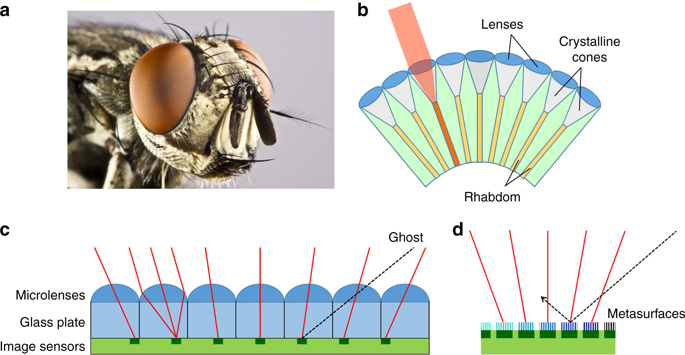Nature Communications ( IF 14.7 ) Pub Date : 2020-04-02 , DOI: 10.1038/s41467-020-15460-0 Leonard C Kogos 1 , Yunzhe Li 1 , Jianing Liu 1 , Yuyu Li 1 , Lei Tian 1 , Roberto Paiella 1

|
The vision system of arthropods such as insects and crustaceans is based on the compound-eye architecture, consisting of a dense array of individual imaging elements (ommatidia) pointing along different directions. This arrangement is particularly attractive for imaging applications requiring extreme size miniaturization, wide-angle fields of view, and high sensitivity to motion. However, the implementation of cameras directly mimicking the eyes of common arthropods is complicated by their curved geometry. Here, we describe a lensless planar architecture, where each pixel of a standard image-sensor array is coated with an ensemble of metallic plasmonic nanostructures that only transmits light incident along a small geometrically-tunable distribution of angles. A set of near-infrared devices providing directional photodetection peaked at different angles is designed, fabricated, and tested. Computational imaging techniques are then employed to demonstrate the ability of these devices to reconstruct high-quality images of relatively complex objects.
中文翻译:

无晶状体复眼视觉的等离子小眼。
昆虫和甲壳类动物等节肢动物的视觉系统基于复眼结构,由指向不同方向的密集的单个成像元件(小眼)阵列组成。这种布置对于需要极端尺寸小型化、广角视场和高运动灵敏度的成像应用特别有吸引力。然而,直接模仿常见节肢动物眼睛的相机因其弯曲的几何形状而变得复杂。在这里,我们描述了一种无透镜平面架构,其中标准图像传感器阵列的每个像素都涂有一组金属等离子体纳米结构,该结构仅传输沿着小的几何可调角度分布入射的光。设计、制造和测试了一组提供在不同角度达到峰值的定向光电检测的近红外设备。然后采用计算成像技术来证明这些设备重建相对复杂物体的高质量图像的能力。

































 京公网安备 11010802027423号
京公网安备 11010802027423号